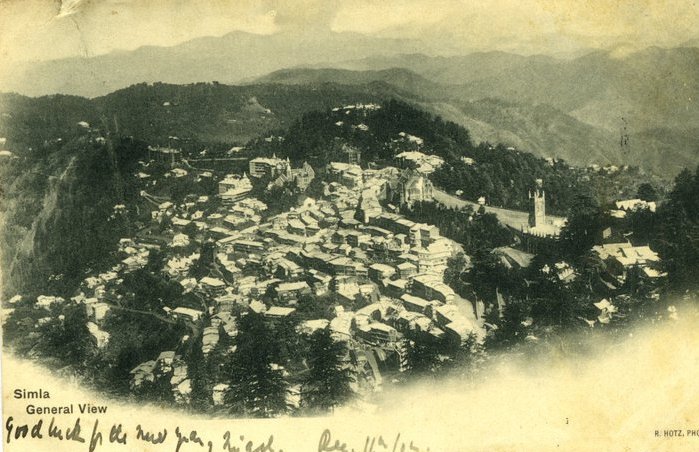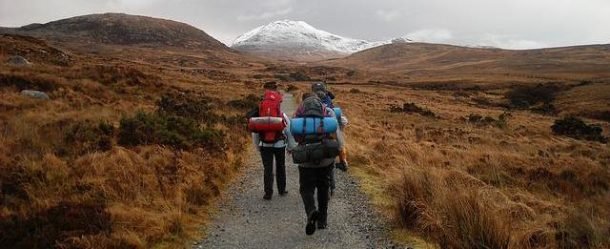
A General View of Simla in 1910.
Photo by – R. Hotz
‘Taking everything into consideration we may, therefore, decide that when the Blaini roup was being deposited, the spot now occupied by Simla was a sea on whose surface icebergs floated, melted and dropped the stone which they carried on their surface, or imbedded in their substance’ – wrote R. D. Oldham and officer of survey department in 1887.
The effect of the chillness created by the icebergs can still be realized around the Ridge of Shimla. And the climate of this place is formed due to this chillness. The army officer who moved the Gurkha troupe from Subathu to Kotgarh in 1816, after the Anglo Gurkha war was overwhelmed to have found a tiny village with twelve hamlets set up on the southern slope of a spur, and camped here for a few days.
That was the month of April and the spring in the hills was around. The sunny days with a crispness in the air were invited him to walk through the forested trails, bask on the glades and enjoy the red effect created by the flowers of Rhododendrons. He was just pampered by the climate of this place and said that it resembles Scotland. Unfortunately, today we do not have any of those twelve houses from village Shyamala.
Shyamala to Simla
A few years later village Shayamala was merged in the boundary of the town named as Simla, by Captain Kennedy who designated the boundary by obtaining eighteen villages from the local ruler. Simla rose its head towards its future as Summer Capital of Imperial India.
Shyamala, which was called Simla, with affection, by the British stepped forward first to become the retreat, then a sanitarium and then the Summer Capital of British India. People began to move up to the hills. A new lifestyle had arrived here. The natives were surprised to see a number of white men and women moving up to the hills and that was just to escape the heat of the plains. With everything that was essentially required to lead life smoothly, they traveled from Calcutta on their bullock carts and camel carts. On the way, there was no place to stay, as there were no Inns or hotels, no water facilities, no electricity, and the roads were also not tarred. Every year the travelers expedited to the hills through the tough terrain.
On the way, there were rivers and jungles to cross and because of that, they had to travel long distances sometimes till late at night. Next morning, in many cases the horse and the cart were found lying on ninety angles.
Simla – A Summer Capital
Shimla remained the Summer Capital of British India from 1864 to 1947, when Indian found independence. During that period it found immense growth as a hill station and a summer retreat. The British built everything that was essentially required to lead life smoothly. And now after two hundred years, Shimla is the capital of Himachal Pradesh – a hill station in the North of India, in the Himalayan foothills. It is on the world tourist map and especially for the British, it is one of the must visit places in India.
We the natives enjoy every season of Shimla. Summer is mild and the mountain breeze keeps the weather cool and pleasant. It is only in the month of June when we sweat a little bit while following an uphill path. We have a long winter that may extend from five to six months. The chilly weather of Himalaya sometimes can be extremely cold that drips the temperature as low as minus seven degrees at night. The best view of the Himalayan landscape can be enjoyed only during the monsoon when the mist rises from the valleys and spreads everywhere. Every moment the scenes change dramatically. It is impossible to move out of the house without carrying an umbrella and rain cover.
Shimla invites everyone to its lap to enjoy its beauty. There are different ways to see and roam around Shimla. Still, it is surrounded by the thickest forest cover in Asia. If you love the wilderness come to Shimla but the only condition is that you will not play with the decorum of the city and will also not disturb the ecology and the local lifestyle with your city behavior.
Shhimla – on World Tourist Map
Shimla, as a tourist destination, holds a great attraction for the everyone and also it is the base for many high altitude treks and safaris to the Trans Himalayan regions. You may come to spend a few days in Shimla and go back or you can use it as your base to go beyond it and explore more of the hills. The upper regions of Shimla offer lovely treks and jeep safaris. Depending upon your taste, time and budge Shimla Walks organizes and conducts various tours to the Trans Himalayan regions. We would love to hear from you for your future holiday and would like to have the privilege of organizing a trip for you in our lovely country.

